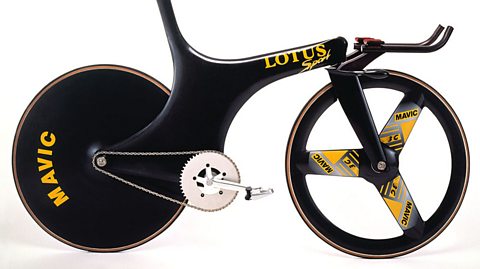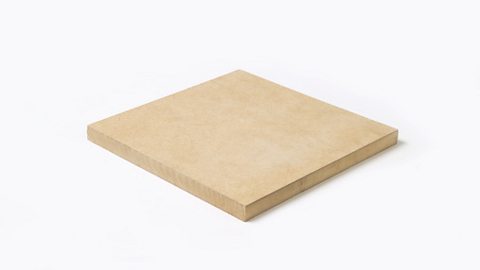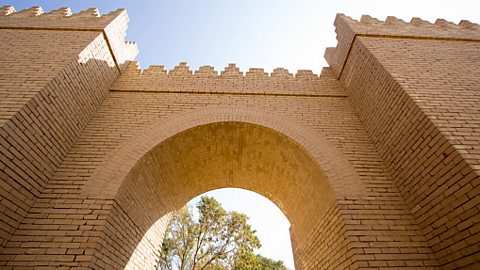Key points
- Composite materials are made from two or more different types of material.
- Composite materials are synthetic and are made by a chemical process.
- Composite materials are designed for specific uses.
Are there any composite materials in the periodic table?
No, composite materials are made from two or more materials.
Only elements are listed on the periodic tableA table which lists all of the chemical elements. Remember that an element is made from only one type of atom.

Video
Watch this video to see how transforming concrete into a composite material overcomes any weaknesses found in concrete.
While you’re watching, look for how the properties of steel and concrete work together in the reinforced steel.
Transforming concrete into a composite
Dr Phil Panell has been studying concrete for over 15 years and I’ve come to find out how to solve the problem of its weakness.What is this trick? I mean, what is the answer to making concrete stronger, resisting these bending forces?
Well, back in the 1850s, there was a plasterer from Newcastle called Mr Wilkinson and he was making concrete floor slabs and what he noticed was that these slabs had a tendency to crack in between the joints.
Just like my unfortunate experience with the plank.
Exactly like your unfortunate experience with the plank.
So, Wilkinson noticed where the cracks were appearing in his concrete floor slabs and he had an idea, and a very bright idea. And he took some barrel hoops. He took some of the flat hoops that go around and hold a barrel together, and he placed them in the concrete where he noticed the cracks were appearing, where he knew we had to resist these pulling forces.
So he invented reinforced concrete.
He did, back in 1853.
What a dude.
Absolutely. He laid the foundations for modern urban life. Without reinforced concrete, nothing we see around us would exist.
Reinforced concrete might seem simple, but it works because steel is the perfect partner for concrete. They both share a surprising quality. They expand and contract at the same rate when they get hot or cold. And unlike concrete, steel is strong when it’s under tension. It bends without breaking like concrete does.
Concrete and steel are very different materials but which property do they have in common?
Concrete and steel expand at the same rate when heated, which is critical to its many applications.
For example, the weather in the UK can range between –5°C and 40°C so a bridge made from reinforced concrete needs to expand predictably in warmer weather.
What are composite materials?
Composite materials are made from two or more different types of material.
The materials for a composite material are chosen because they have different propertiesThe properties of a substance are the qualities and characteristics of a substance that describe and identify it. that combine to make a more useful material. The properties of each material in the composite are described as complementingWhen two or more things are complementary it means they combine in such a way as to enhance qualities of each other. each other.
Examples of composites
1. Reinforced concrete
Reinforced concrete is a composite material. It is made by pouring concrete around a mesh of steel cables. When the concrete sets, the material is:
- strong when stretched (because of the steel)
- strong when squashed (because of the concrete)

| Use of reinforced concrete | Why? |
|---|---|
| Construction of bridges | Reinforced concrete is strong in compression and can flex slightly without cracking. |
| Construction of tall buildings | |
| Fence posts |
Based on the properties of concrete and steel, explain why reinforced concrete is used for constructing tall buildings and fence posts.
| Use of reinforced concrete | Why? |
|---|---|
| Construction of bridges | Reinforced concrete is strong in compression and can flex slightly without cracking. |
| Construction of tall buildings | Reinforced concrete can be made into a variety of shapes and is very strong under compression, meaning the base of the building will not break under the weight of the upper storeys. |
| Fence posts | Fence posts were traditionally made from wood which rots over time. Reinforced concrete fence posts are very strong and do not rot, so they last for a much longer time. |
2. Breathable fabrics
Nylon is a polymer and it has some desirable properties:
- it is tough
- it is lightweight
- it is waterproof
These properties could make it a useful fabric to make a waterproof coat.
However, the fact that nylon is waterproof means it does not let water vapourA gas formed when a liquid evaporates or boils. pass through it. This means it traps sweat, and after a while the clothing becomes wet inside and unpleasant to wear.
This can be solved by using composite materials.
Breathable fabrics are composite materials which have the desirable properties of nylon, but are 'breathable'. They stop raindrops getting in while letting water vapour from sweat pass to the outside.
Based on these properties, can you think of any examples of what breathable fabrics might be used for?
Breathable fabrics are useful in clothing.
For example, clothing made of such materials is very useful to hikers and other people who work or play outside.

3. Fibreglass
Fibreglass is made from a mesh of glass fibres set in a tough polymerA polymer is a very long chain molecule made up of many repeating units. The glass fibres make the material strong, the polymer makes it lightweight. These properties make it useful for making these kayaks which have to float and could be bumped by rocks when travelling down a river.


4. Carbon fibre reinforced polymer (CFRP)
Carbon fibre reinforced polymer (CFRP) is made from carbon fibre which is strong and light but very flexible, and a polymer resin which is stiff but weak. CFRP is stiff, strong and light which makes it ideal for designing cutting-edge racing bike frames.


5. Medium density fibreboard (MDF)
MDF is made from wood fibres and glue. It is easy to shape, flexible and is easily painted and glued. It can be made into different thicknesses. This makes it useful for making furniture.

Carbon fibre reinforced polymer is a composite material used in high performance cars and sports equipment. Carbon fibre is flexible and very strong. Polymer resin is brittle.
Why would neither of these materials be suitable on their own?
These materials wouldn't be suitable on their own because:
- carbon fibre on its own wouldn’t hold the required shape for the car part or piece of sports equipment
- resin would break too easily
However, a composite made from both materials has excellent strength, flexibility and keeps its shape.
Development of composite materials over time
Composite materials tend to be thought of as being modern materials. However, they have a very long history.

From 3400BC, the first composite materials were made by the Mesopotamians. These ancient people glued wood strips at different angles to create a composite material called plywood.


Bakelite, the first fibre reinforced polymer (FRP) was invented in 1907 in New York. Whilst it was originally used for many things, it is now most famous as the material used to make old fashioned telephones.


The 1930s are considered the most important decade in composite development. The petrochemicalSubstance made from crude oil using chemical reactions. industry was growing rapidly, producing the raw materials needed and World War One had increased interest in new materials. In 1935 many polymers reinforced with fibres were developed and in the 1940s the first fibreglass appeared.


Did you know?
Many early composite materials used different natural materials. For example, ancient builders used straw to reinforce mud bricks. The Great Wall of China was even built by using a composite mortarUsually mixture of sand, water, and cement or lime that is used to fix bricks or stones to each other when building walls. made with sticky rice!


Why did the development of plastic composites not develop until the 1900s?
Plastics weren’t developed until the 1900s. It was only in the late 19th century that a proper chemical industry developed.
Test your knowledge
Quiz
Play the Atomic Labs game! gamePlay the Atomic Labs game!
Try out practical experiments in this KS3 science game.
